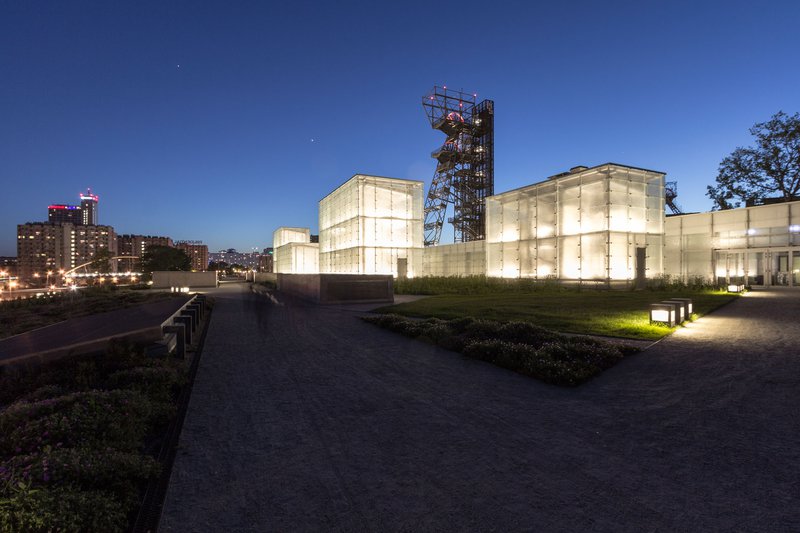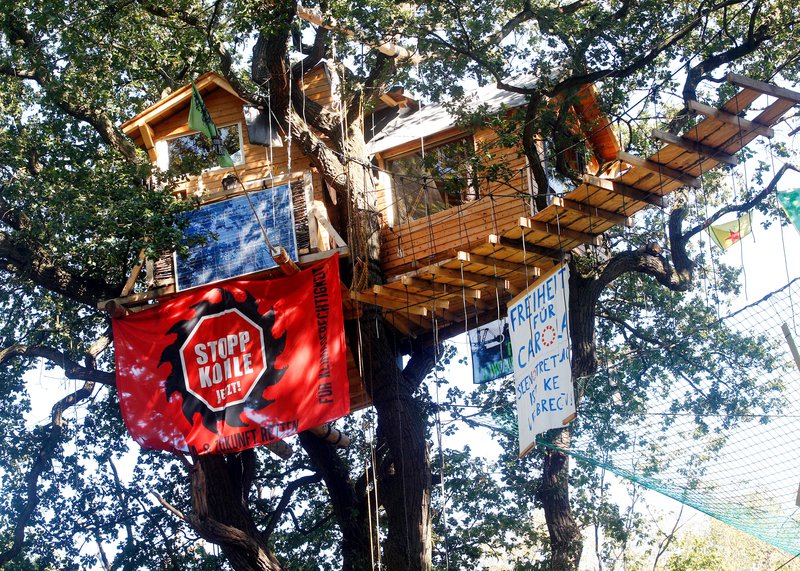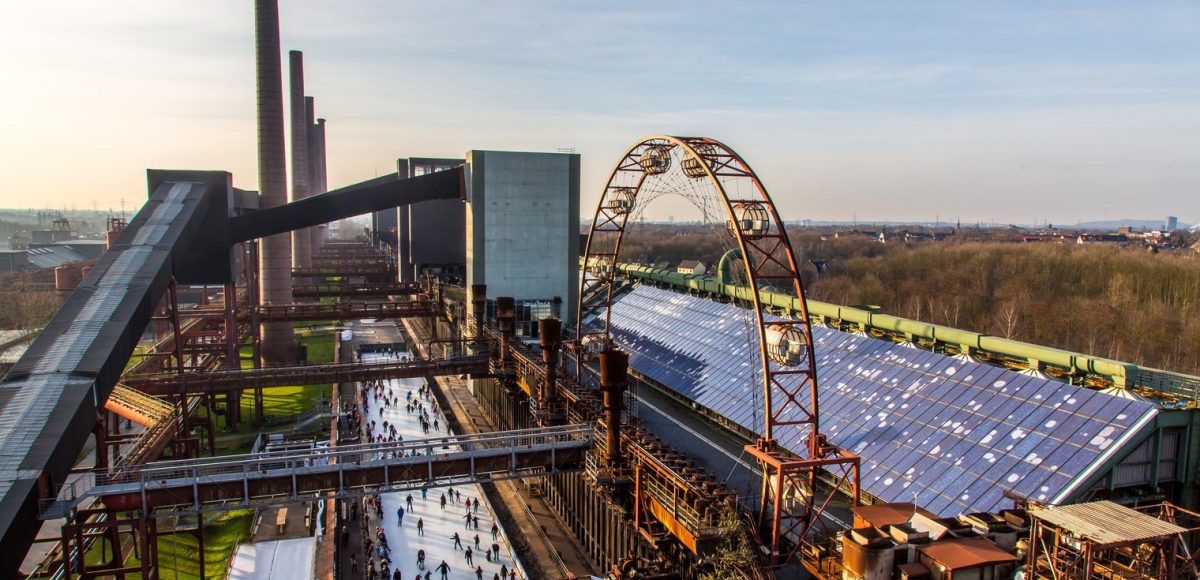Originally published on Open Democracy.

| Image: Jochen Tack / Zollverein Foundation
In the Ruhr valley, amid the silent structures of what was once the largest coking plant in Europe, school children ice-skate underneath ovens and smokestacks that once burned up thousands of tons of coal each day to acquire the vast quantity of heat and energy required in the making of steel.
The ice-rink forms part of the Zollverein Coal Mine Industrial Complex – closed in 1986 and now a UNESCO World Heritage Site. Today the complex hosts an eclectic mix of post-industrial entities – startups, a restaurant, a centre for contemporary arts, a design museum, and, in the former coal-washing plant, the Ruhr Museum – dedicated to interpreting the region’s history.
The Ruhr was once the epicentre of West Germany’s Wirtschaftswunder – the country’s ‘miraculous’ economic recovery from the devastation of conflict. The coal and steel production facilities of the Ruhr, integrated into the new European Coal and Steel Community (the initial precursor to today’s European Union) underpinned a new era of post-war prosperity and optimism.
Dr. Frank Kerner, Deputy Director of the Ruhr Museum, sees clear historic parallels between that moment of European integration and post-war recovery, with today’s continent-wide transition challenge:
“If the nucleus of Europe was the Coal and Steel Community, and if this is far away in the past, we need to define the nucleus of a new of Europe.”
“We’ve had peace here for 40 years, and that’s not normal…It may be that the end of coal and steel in Western Europe is a great problem for Europe itself.”
Policy makers in Brussels are not oblivious to the magnitude of the task. EU Commission President Ursula Von der Leyen recently framed the march towards decarbonisation as Europe’s “man on the moon moment.”
The Commission’s Green Deal – the much anticipated slate of big policy proposals that aims to mitigate the catastrophic impacts of carbon based industrial development – is said to make the march to carbon neutrality inevitable.
While significant details of the project are still to be defined, the trajectory of the Green Deal is consistent with European history in one predictable respect – the pursuit of “green” growth is central.
But a new Wirtschaftswunder, or the arrival of a second Trente Glorieuses, is incompatible with the decade of radical action demanded by the International Panel on Climate Change.
For many experts, green growth is an oxymoron: most scenarios that present it as feasible are largely conditional on unproven technologies for carbon removal.
But even with some form of smart carbon tariff regime to tackle emissions that are currently offshored, the goal of an exponentially growing European economy sits awkwardly alongside the Commission’s plan to become the first carbon-neutral continent by 2050.
If economic convergence is a basic article of faith that binds the EU project together in troubled times, even in the face of planetary emergency, it can feel blasphemous to suggest that some might have to learn to live with less.
The Ruhr lies in North-Rhine Westphalia – the largest, dirtiest, and wealthiest of Germany’s sixteen federal states.
The mining culture here – proud, militaristic, resilient, and formed by waves of migration – is uncannily similar to that of Silesia, some 600 miles to the east in Poland: both were once frontiers of the Prussian Empire, and both became industrial heartlands.
In Silesia’s capital Katowice, coal is still an unavoidable fact of life. From the smog generated by thousands of coal-burning domestic hearths, to the veneration of St Barbara (the patron saint of miners) – coal remains a living part of this region’s culture.
Silesia therefore represents another frontline in Europe’s transition. The role is fitting: the region has long sat at the crossroads of European geopolitics. As a result, the numerous ideological, political and economic changes that have shaped this corner of Poland remain close to the surface.
The iconic Silesian Museum (Muzeum Śląskie) in Katowice, with its monumental underground exhibition halls set underneath the winding gear of a former colliery, sets out to celebrate this complex history.
“Our new buildings, the glass boxes, discuss with the past, and that’s a really, really, beautiful metaphor for us. So this building is really telling you, there’s no one Upper Silesia…This is a work in progress, always,” Alicja Knast, the museum’s director, explains.
Like many cities which sprang up at breakneck speed during the great revolution sparked by the emergence of fossil capital 200 years ago, for Katowice, access to coal was existential.
“The coal mine is older than the city itself – so the city actually came to surround the coal mine,” says Knast.
The museum has engaged extensively with miners since it came to occupy the former colliery site. Its frosted glass exterior is adorned with motifs taken from a former miner’s painting, inspired by an ancient fossil discovered on a lump of coal.
“I think museums play a very important role in this really very difficult process of switching from heavy industry to something else,” Knast tells me.
If the cultural process of transition is well underway – hard economic and social realities may prove more challenging, and costly, to shift.
In the small town of Imielin (population 9,000) near Katwoice, residents are engaged in a protracted battle with state-backed coal giant Polska Grupa Górnicza (PGG). The firm hopes to open a new mine directly underneath the town itself.
The town is a microcosm for wider debates about energy, prosperity and the social consequences of coal consumption which the continent will have to tackle.
“We don’t want to sacrifice our town for mining companies or money,” says Alicja Zdziechiewicz, a local teacher and activist from the Zielony Imielin campaign.
Within this community, the negative social impacts of coal – subsidence of homes and infrastructure, some of the worst air quality in Europe, and risks to public water supplies – compete with the traditional stability of employment for miners, in a country that has one of the most precarious workforces in Europe.
“Of course we get opposition not only from PGG but also from people who are working for the coal mine nearby … not everyone is protesting because 200 miners are living here, with a family if you sum it up this is around 1000 people,” adds Alicja’s colleague, Ireneusz Górniok.
The government’s relationship with coal, which feeds 80 per cent of the country’s electricity supply, was undoubtedly a significant factor in the Polish government’s refusal to sign up to the EU’s Green Deal project.
PGG recently awarded a bonus to miners prior to the last national elections: a reminder that the Polish state’s attachment to coal will take enormous political will to shift. While hundreds of thousands have left the trade since 1990, there are still around 80,000 miners employed in the Polish coal sector.
Patryk Bialas, an environmental activist and city councilor in Katowice, tells me that his grandfather, a lifelong miner, made it clear that he didn’t want his grandson to follow him into a career underground: “I took this lesson seriously from the very beginning,” he says.
For Bialas, the key to a just transition from coal in the region is to ensure that mining jobs are not simply replaced with precarious work: calling instead for workforce skills to be retained and redeployed in low-carbon projects.
“My personal experience from discussions with miners is that, of course people are afraid of change, of a future which is, sometimes, difficult to foresee. But if you provide them with security they will elect you once again. You need to provide them with hope,” he explains.

Back in North-Rhine Westphalia, major confrontations in the struggle to determine the shape of Europe’s energy future are taking place.
This year, moves towards a consensus based ‘coal exit’ have been a prominent feature of German politics. The aspiration is to phase out all coal-fired power in Europe’s biggest economy by 2038.
However, delivering this stated aim alongside the provision of compensation to energy firms has proven to be a major legislative challenge.
Not far from the state’s urbanised economic powerhouse, Hambach Forest, a unique ancient woodland, has become a symbolic battleground between fossil capital and climate activism.
Once held by locals as common land, known as the ‘citizens forest’ – only ten per cent of the original woodland remains, with the vast majority already swallowed up by an open-cast lignite mine. The mine, which first broke ground in 1978, is owned by energy giant RWE and is now the largest facility of its kind in Europe.
Under the coal exit scheme, RWE CEO Rolf Martin Schmitz recently claimed that his company would expect to receive roughly 25 billion Euros in state compensation in exchange for taking all of its lignite plants off-grid.
This high-stakes process of legislative wrangling has been matched with volatility on the ground in the area around Hambach. Andreas Büttgen, from local campaign group Buirer für Buir, based in a nearby village, explains what it’s like to live near the mine:
“You see that every day the home, nature, climate right on our doorstep is destroyed, even though the coal phase-out is to come and other countries have agreed on very ambitious exit goals.”
But despite threats to the remains of the forest and to the viability of communities nearby, many locals have close to ties to the mining industry.
“The mood in our village is very divided. Around a third of the approximately 4,000 inhabitants are closely connected to RWE,” says Büttgen.
In campaigning against the coal mine, Büttgen has been the victim of intimidation and has received a death threat. A campaign vehicle, a converted fire-engine, was destroyed in an arson attack.
For both sides, the struggle feels existential.
The fate of the forest itself, which has been occupied by protestors for seven years, remains uncertain. However, successive abortive attempts to evict the forest’s inhabitants have turned this place into a struggle of national significance.
Today, several camps consisting of treehouses are populated year round by a range of people with a multitude of backgrounds and political affiliations.
One of the oldest protestors, a former metal worker and union shop steward, has sought to make common cause with the workers at RWE.
“The discussion of this movement has to go to the workers in the factories and also in the mines: climate change dictates to us that we must have a system change,” they tell me.
“The environment movement and the workers’ interests, to save their jobs and to organize their lives in society, should have the same enemy, the companies and the capitalistic system. This this is a discussion we have to organize, and it’s just beginning.”

The Indian writer Amitav Ghosh notes: “it could be argued that miners, and therefore the economy of coal itself, were largely responsible for the unprecedented expansion of democratic rights that occurred in the West between 1870 and the First World War.”
In December 2018, a few miles from the iconic winding gear at Zollverein, the last hard coal mine in the Germany closed its doors. It was an emotional affair. A great square lump of coal hewed out on the last shift sits in the entranceway of the Ruhr museum.
Dr Kerner explains the significance mining work to the region’s identity: “under the earth you…have to work together, if anyone makes a mistake it’s a great problem for all.”
“This is a pact of working together. This was solidarity, not taught by a teacher in the class, but learned in reality.”
Ultimately, a failure to understand the history of coal regions threatens the viability of the entire European project. In these regions, voices from the past tell us that only a radical vision of a Green New Deal, with an expansion of democratic rights at its heart, will suffice.
With climate change-denying nationalist populism on the rise across Europe’s post-industrial regions, solidarity can often seem like an empty, outdated, concept. But without it, the EU Commission may soon find that the end of coal only exacerbates underlying tensions and regional inequalities.
For Europe, the struggle for carbon-neutrality has only just begun.
In December 2019 Chris Silver travelled to Europe’s coal regions as part of Enough! Scotland’s Radical Routes Project. Enough! aims to explore degrowth and deep adaptation through ideas, art, community activism and low-carbon travel. @enoughscot
